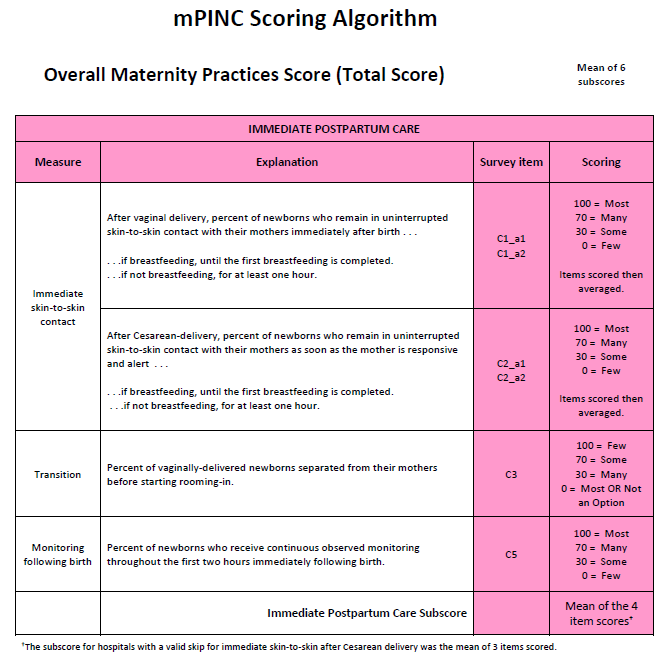Scoring: Maternity Care Practices
Maternity Practices in Infant Nutrition and Care (mPINC)
CDC calculates a Total mPINC score for every participating hospital to indicate its overall level of maternity care practices and policies that support optimal infant feeding. A Total mPINC score is provided in the individual hospital reports. Subscores further categorize maternity care practice subdomains:
- Immediate Postpartum Care
- Rooming-In
- Feeding Practices
- Feeding Education & Support
- Discharge Support
- Institutional Management
Responses are scored using an algorithm that denotes the evidence and best practices to promote optimal infant feeding within the maternity care setting. Possible scores range from 0 to100, with higher scores indicating better maternity care practices and policies.
mPINC Scoring Algorithm
Overall Maternity Practices Score (Total Score) Mean of 6
| IMMEDIATE POSTPARTUM CARE | |||
|---|---|---|---|
| Measure | Explanation | Survey item | Scoring |
| Immediate skin-to-skin contact | After vaginal delivery, percent of newborns who remain in uninterrupted skin-to-skin contact with their mothers immediately after birth …
|
|
|
After Cesarean-delivery, percent of newborns who remain in uninterrupted skin-to-skin contact with their mothers as soon as the mother is responsive and alert …
|
|
|
|
| Transition | Percent of vaginally-delivered newborns separated from their mothers before starting rooming-in. | C3 |
|
| Monitoring following birth | Percent of newborns who receive continuous observed monitoring throughout the first two hours immediately following birth. | C5 |
|
| Immediate Postpartum Care Subscore | Mean of the 4 item scores† | ||
| †The subscore for hospitals with a valid skip for immediate skin-to-skin after Cesarean delivery was the mean of 3 items scored. | |||
| ROOMING-IN | |||
|---|---|---|---|
| Measure | Explanation | Survey item | Scoring |
| Rooming-In | Percent of newborns who stay in the room with their mothers for 24 hours/day (not including separation for medical reasons). | C4_a1 |
|
| Mother-infant separation | Indicates usual location of newborns during…
|
|
|
| Rooming-in safety | Indicates whether your hospital has a protocol requiring frequent observations of high-risk mother-infant dyads by nurses to ensure safety of the infant while they are together. | C7 |
|
| Rooming-In Subscore | Mean of the 3 item scores | ||
| FEEDING PRACTICES | |||
|---|---|---|---|
| Measure | Explanation | Survey item | Scoring |
| Formula- feeding of breastfed infants | Percent of healthy, term breastfed newborns who are fed infant formula. | D3_A1 |
|
| Glucose monitoring | Indicates whether your hospital performs routine blood glucose monitoring of full-term healthy newborns NOT at risk for hypoglycemia. | D5 |
|
| Formula counseling for breastfeeding mothers | Frequency that staff counsel breastfeeding mothers who request infant formula about possible health consequences for their infant and the success of breastfeeding. | E3 |
|
| Feeding Practices Subscore | Mean of the 3 item scores | ||
| FEEDING EDUCATION & SUPPORT | |||
|---|---|---|---|
| Measure | Explanation | Survey item | Scoring |
| Formula preparation & feeding techniques | Among mothers whose newborns are fed any formula, percent of mothers taught…
|
|
|
| Feeding cues & Pacifiers | Percent of breastfeeding mothers who are taught or shown how to …
|
|
|
| Identify/solve breastfeeding problems | Percent of breastfeeding mothers who are taught or shown how to…
|
|
|
| Feeding Education & Support Subscore | Mean of the 3 item scores | ||
| DISCHARGE SUPPORT | |||
|---|---|---|---|
| Measure | Explanation | Survey item | Scoring |
| Pre-discharge criteria | Indicates whether your hospital’s discharge criteria for breastfeeding newborns requires …
|
E5_a2 |
|
| Post-discharge follow-up visit |
|
E5_a3 |
|
| Post-discharge breastfeeding support | Indicates whether your hospital’s routine discharge support to breastfeeding mothers includes:
|
|
|
| Distribution of infant formula or formula- related supplies/ coupons as gifts | Indicates whether your hospital gives mothers any of these items free of charge (not including items prescribed as part of medical care):
|
|
|
| Discharge Subscore | Mean of the 4 item scores | ||
| INSTITUTIONAL MANAGEMENT | |||
|---|---|---|---|
| Measure | Explanation | Survey item | Scoring |
| Nurse skill competency | Indicates which competency skills are required of nurses: Placement and monitoring of the newborn skin-to-skin with the mother immediately following birth. |
|
|
| Assisting with effective newborn positioning and latch for breastfeeding. | |||
| Assessment of milk transfer during breastfeeding. | |||
| Assessment of maternal pain related to breastfeeding. | |||
| Teaching hand expression of breast milk. | |||
| Teaching safe formula preparation and feeding. | |||
| Nurse competency assessment | Assesses whether formal assessment of clinical competency in breastfeeding support and lactation management is required of nurses. | F3 |
|
| Documentation of exclusive breastfeeding | Indicated whether your hospital records/tracks exclusive breastfeeding throughout the entire hospitalization. | G1_a1 |
|
| Acquisition of infant formula | Indicates how your hospital acquires infant formula. | G4_a1 |
|
| Written policies | Indicates whether your hospital has a policy requiring…
|
|
|
| Institutional Management Subscore | Mean of the 5 item scores | ||
| ‡ G2_a5 and G2_a6 as well as G2_a8 and G2_a12 are combined. Responses of Yes/Yes received a score of 100, other responses received a score of 0. Note: Subscores are not provided if half or more of the items in the section do not have a score. Total score is not provided if any subscore is missing. | |||

